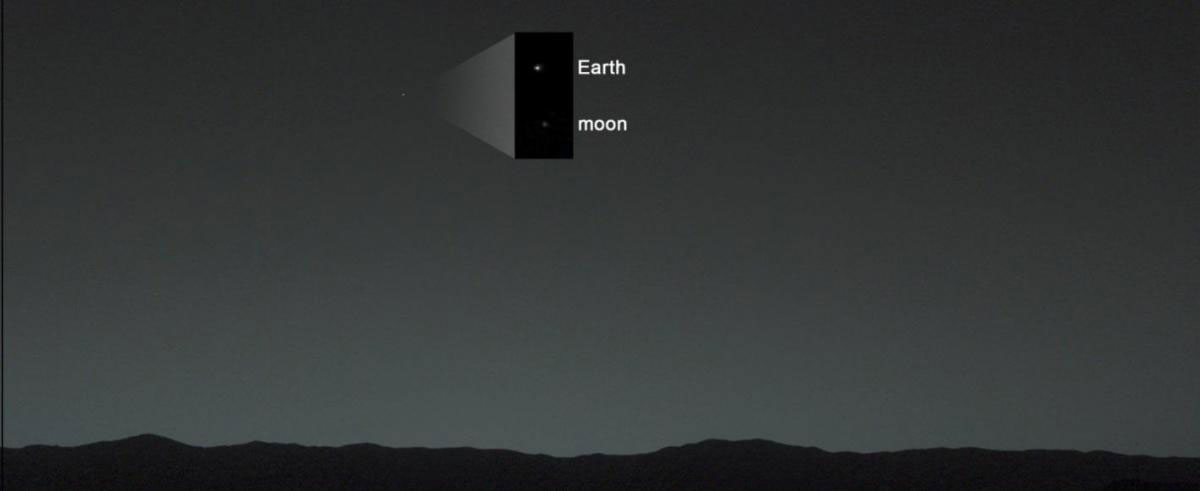Challenge 14 – Time on Mars
The Curiosity rover has been operating on the surface of Mars since August 6, 2012 exploring the geology of Gale Crater. During its travels it has taken thousands of unique pictures of Martian rocks and hills, but also of our own Earth, which appears as a bright star in the sky.
Earth from Mars
Credit: NASA / Curiosity
This picture was taken by Curiosity about 80 minutes after sunset. A human observer with normal vision, if standing on Mars, could easily see Earth and the moon as two distinct, bright "evening stars."
Although this image was taken on January 31, 2014, astronomers recon time on Mars using a different method. Mars rotates on its axis once every 24hours and 39 minutes. By comparison, a ‘solar day’ on Earth is exactly 24 hours long. To avoid confusion, spacecraft measure the passage of time in terms of Martian Sols, where 1 Sol is the time for a full rotation of Mars. Also, for each mission that lands on Mars, that day is called Sol-0. In terms of Earth-time, Sol-0 for the Curiosity Rover is August 6, 2012, but for the Mars Phoenix mission, Sol-0 is May 25, 2008. As for the Earth day, a Sol begins at local midnight, and although the Martian day is 39 minutes longer than an Earth day, by convention, astronomers and spacecraft operators assume a 24-hour day on Mars.
Problem 1 – If a Martian day is 24 Martian hours long, how many Earth minutes long is a Martian minute?
Problem 2 – If Sol-0 for the Curiosity lander corresponds to August 6, 2012, what Sol was it at Curiosity for the Earth date August 30, 2012?
Problem 3 – What will be the Sol on Mars for Curiosity at the time of the August 21, 2017 total solar eclipse?
To get the actual hour and minute on the Mars clock takes a bit more work. On Earth we use Greenwich Mean Time as our zero-hour to set up Earth time zones, which increase for longitudes to the west of Greenwich. New York, which is in the Eastern Daylight Time (EDT) zone, is four hours behind Greenwich time. That means that in London, Noon there (GMT) corresponds to 8:00 am EDT in New York City. On Mars, astronomers have set up a similar series of time zones all around the planet. To translate from a particular time on Earth in the GMT or EDT system to predict what a Martian clock will read, you have to follow a series of steps that allow for changes in the length of days and zero points for the various clock systems. Let’s try an example!
We want to find out what Sol and time it is on Mars at the Curiosity rover for April 30, 2016 at 13:00 UT, which is the same as 9:00 am EDT.
Step 1: Calculate the Julian Date for April 30, 2016 at 13:00 UT. To do this, visit the US Naval Observatory and use their online form: http://aa.usno.navy.mil/data/docs/JulianDate.php. The answer is 2457509.049306.
Step 2: Calculate the Martian Julian Day Number (MSD) for this Earth date and time.
Julian Days are based on Earth solar day of 24 hours, but a Martian day is 24:39. The adopted convention is that the mars clock will also be a 24-hour clock but all time intervals will be expanded by 24:39 / 24:00 = 1.02749. So the Mars Julian day number (MSD) starts on Earth JD 2405522.00 (December 29, 1873) and the Mars clock minutes and hours are 1.02749 times longer. The 1873 date was shortly before the date when the crater Airy was used to mark the Martian Prime Meridian.
MSD = (2457509.049306 – 2405522.0028779)/1.02749 = 50596.0965
Step 3: Just as Earth has its GMT, also called Universal Time or UT, there is a Mars Universal Time called MTC based on the 24-hour Mars clock. MTC is based on the Martian Prime Meridian of longitude at 0o, which passes through the exact center of the crater Airy. To find MTC, just take the fractional part of the MSD and multiply by 24 Martian hours: MTC = 0.0965 x 24.0 = 02:19
Step 4: The longitude of the curiosity rover in Gale Crater is 137.4 East of Airy Crater. This corresponds to a time of 24x(137.4/360) = 9.16 hours or 09:10 later than MTC, so the local time at Curiosity is then 02:19 + 09:10 = 11:29 am.
Problem 4 – An astronomer wants to see if Curiosity will be able to see the total solar eclipse on August 21, 2017, which occurs at 18:00 UT. If the Julian Day for this date and time is 2457987.25, what is the Mars local time for this event?






